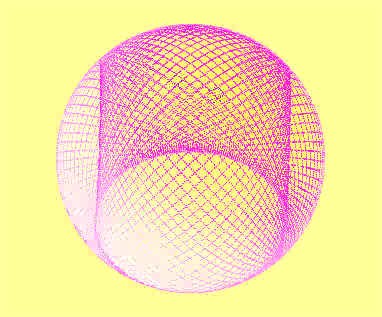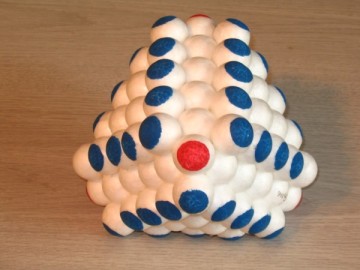.jpg)

Diamond



Mills
Orbitsphere
Orbitsphere
White Tin
Neutron Decacores
Revisting Our Atomic Theories
(Sample Portions From The Hydreno Ebook)
Fractional Quantum States of Hydrogen
The assertion that hydroxy-gas implosion may result in sub-grounds states of hydrogen finds compelling supporting evidence from the recent discovery by R. Mills[22] of a form of hydrogen with the electron in a fractional quantum orbital, well below the normal ground state of the K shell. This compact form of hydrogen, referred to as the Hydrino, can apparently exist in many different fractional quantum states, with an electron orbital that does not radiate....
The orbital electron in this case is conjectured to be a composite, standing EM wave comprised of radial, spherical and time harmonic functions, which together define a spherical shell or orbitsphere with an “orbiting” zone of dense charge with clearly defined spatial dimensions surrounding the proton with all of the electromagnetic and centrifugal forces in balance....
This orbitsphere electron can also exit in a free state analogous to an ordinary balloon or soap bubble of essentially no internal substance, but possessing a relatively large well defined and presumably flexible volume. The conventional notion of a singular point charge, material particle, whirling about the nucleus is consequently discarded. This very real wave-particle electron replaces the purely statistical wave functions of conventional Quantum mechanics that evolved from the contributions of Heisenberg, Born, Schrodinger and Hund with their compounding of assumptions and apparent errors....
Theory on the hydrino is based in a highly deterministic, classical version of Quantum mechanics claimed to be wholly consistent with Maxwell’s original equations of electromagnetism and many other well established universal constants and phenomena although the Heisenburg's uncertainty principle takes a rather thorough thrashing. Myron Evans is yet another respected theorist, who also advocates a return to a more deterministic form of Quantum theory....
Evans claims to eliminate the glaring inconsistencies in the standard EM model that have crept in primarily as a result of Heaviside’s vector simplification of Maxwell’s original equations. The most embarrassing of these being the total absence of any explanation of the source for the electric field energy that continually radiates from all point charges at the velocity of light. It should be obvious by now that this field actually results from the continual coherence of the random ZPE of the vacuum arising from its interaction with the fundamental particles of matter....
Refinements To The Electron/Positron Model
In addition to the composite standing wave, force field electron proposed by Mills, other refinements of the point mass model of the electron also exist including those of Tewari, Marris and Sarg. Tewari suggests that the electron and positron are composed of a standing wave, spherical vortex of a massless fluid having zero viscosity. His assertion is that the nucleons are composed of a spherical lattice of these electron and positron vortices arranged in such a way so that they mutually support, rather than annihilate each other. This logical and appealing concept is also entertained here, although along a decidedly different line of reasoning, devoid of the material Ether concept. Indeed, one can visualize several different standing wave forms that might fit the bill for a nucleon lattice structure of this nature....
Certainly the final verdict on the electron’s structure is not in yet. The very recent assertion and supporting evidence for fractional states of the electron, referred to as Electrinos by H. Maris[24], is yet another very interesting development that fits well with Mills' heretical claims about the Hydrino, while throwing further doubts on a fundamental tenet of quantum theory. For the moment its theoretical implications will not be pursued, although it is not hard to envision that a free, standing wave electron might be coaxed into a fractional quantum state in the manner proposed by Mills, or even split into two separate “particles” to form shorter, harmonic overtone standing waves....
Strictly as a matter of convenience and clarity, further discussion relating to the electron and positron will be confined primarily to a loose variant of the Mills hydrino. In order to maintain some necessary distinction from the Mills concept an alternative spelling will be used, replacing the term Hydrino with Hydreno. This also handily removes the implication that we are confining our investigation to only smaller condensed forms of low energy hydrogen. Higher energy forms of nuclear bound hydrogen or hydreno corresponding to every quantum energy state of the orbital electrons is envisioned within the new atomic model....
Refinements To The Proton and Neutron Model
Quark theory on the internal structure of the proton and neutron with all its exotic particles and virtual states is largely the brain child of very complex mathematical formulae, which frequently runs amok from common sense logic and observed reality. Such formulae are also fraught with compounding errors, presumptions and boundary conditions that are frequently little more than speculation. Experimental evidence cited as proof is also dubious at best, given the indirect and extremely transitory nature of such phenomena, which typically discounts the reality of the matter vacuum interaction from the outset.
Momentarily setting aside this mass of quarky confusion with all its colors and flavors and adopting a more pragmatic approach, the nuclear emission of high energy electrons and positrons (b-/+) with accompanying changes of state of the nucleons, logically indicates that they are composed of electrons (negatrons) and positrons, in some sort of stable arrangement, such that electron - positron annihilations do not normally occur....
With the various energy vortex models of the electron and positron fresh in our thoughts, it is not hard to envision how such a lattice of oppositely charged particles might exist. In fact, all of the aforementioned standing waveforms would appear capable of being arranged in a lattice from which the nucleons could be composed of oppositely circulating, mutually supportive positrons and negatrons, in a state of constructive interference, of matched harmonic states. An internal nucleon structure of this form could handily account for the difference between thermonuclear hot fission and the various cold fission reactions that have been historically observed....
Taken to its logical extreme, the existence of the Mills Hydrino would indicate that the orbital electron may be stimulated to shrink by momentarily removing its sustaining energy flow, permitting it to collapse completely on to the nucleus, combining with a proton in a peculiar bound state forming the neutron. It was W. Harkin[25], a contemporary of Bohr, who first suggested that the neutron is simply a bound state of hydrogen in which the charge of the electron and proton are no longer individually discernable. Initially unaware of the implications for the Bohr atomic model, this was conjectured to be true from the outset of this line of inquiry....
The emission of a Beta particle, in conjunction with the conversion of a neutron to a proton, also logically supports this assertion. This seems to be yet another instance where a common sense solution was discarded in favor of an esoteric concept, in order to support an outmoded theory. Furthermore, R. Monti’s[26] comprehensive investigation of the history of atomic theory revealed that D. Borghi[27] reported the synthesis of neutrons from a cold plasma of hydrogen in 1958....
Having repeated the heretical assertion that the neutron is just a bound state of hydrogen, or more simply the sum of a proton and electron, it becomes necessary to take a closer look at other aspects of existing atomic theory with particular emphasis on the still widely accepted Bohr-Rutherford planetary model. Aside from its undisputed accuracy in the prediction of the spectral lines of hydrogen, the Bohr-Rutherford atomic model appears to be in need of some serious rework as suggested in the following section....
© 2006, Mark Porringa
(Sample Portions From The Hydreno Ebook)
Fractional Quantum States of Hydrogen
The assertion that hydroxy-gas implosion may result in sub-grounds states of hydrogen finds compelling supporting evidence from the recent discovery by R. Mills[22] of a form of hydrogen with the electron in a fractional quantum orbital, well below the normal ground state of the K shell. This compact form of hydrogen, referred to as the Hydrino, can apparently exist in many different fractional quantum states, with an electron orbital that does not radiate....
The orbital electron in this case is conjectured to be a composite, standing EM wave comprised of radial, spherical and time harmonic functions, which together define a spherical shell or orbitsphere with an “orbiting” zone of dense charge with clearly defined spatial dimensions surrounding the proton with all of the electromagnetic and centrifugal forces in balance....
This orbitsphere electron can also exit in a free state analogous to an ordinary balloon or soap bubble of essentially no internal substance, but possessing a relatively large well defined and presumably flexible volume. The conventional notion of a singular point charge, material particle, whirling about the nucleus is consequently discarded. This very real wave-particle electron replaces the purely statistical wave functions of conventional Quantum mechanics that evolved from the contributions of Heisenberg, Born, Schrodinger and Hund with their compounding of assumptions and apparent errors....
Theory on the hydrino is based in a highly deterministic, classical version of Quantum mechanics claimed to be wholly consistent with Maxwell’s original equations of electromagnetism and many other well established universal constants and phenomena although the Heisenburg's uncertainty principle takes a rather thorough thrashing. Myron Evans is yet another respected theorist, who also advocates a return to a more deterministic form of Quantum theory....
Evans claims to eliminate the glaring inconsistencies in the standard EM model that have crept in primarily as a result of Heaviside’s vector simplification of Maxwell’s original equations. The most embarrassing of these being the total absence of any explanation of the source for the electric field energy that continually radiates from all point charges at the velocity of light. It should be obvious by now that this field actually results from the continual coherence of the random ZPE of the vacuum arising from its interaction with the fundamental particles of matter....
Refinements To The Electron/Positron Model
In addition to the composite standing wave, force field electron proposed by Mills, other refinements of the point mass model of the electron also exist including those of Tewari, Marris and Sarg. Tewari suggests that the electron and positron are composed of a standing wave, spherical vortex of a massless fluid having zero viscosity. His assertion is that the nucleons are composed of a spherical lattice of these electron and positron vortices arranged in such a way so that they mutually support, rather than annihilate each other. This logical and appealing concept is also entertained here, although along a decidedly different line of reasoning, devoid of the material Ether concept. Indeed, one can visualize several different standing wave forms that might fit the bill for a nucleon lattice structure of this nature....
Certainly the final verdict on the electron’s structure is not in yet. The very recent assertion and supporting evidence for fractional states of the electron, referred to as Electrinos by H. Maris[24], is yet another very interesting development that fits well with Mills' heretical claims about the Hydrino, while throwing further doubts on a fundamental tenet of quantum theory. For the moment its theoretical implications will not be pursued, although it is not hard to envision that a free, standing wave electron might be coaxed into a fractional quantum state in the manner proposed by Mills, or even split into two separate “particles” to form shorter, harmonic overtone standing waves....
Strictly as a matter of convenience and clarity, further discussion relating to the electron and positron will be confined primarily to a loose variant of the Mills hydrino. In order to maintain some necessary distinction from the Mills concept an alternative spelling will be used, replacing the term Hydrino with Hydreno. This also handily removes the implication that we are confining our investigation to only smaller condensed forms of low energy hydrogen. Higher energy forms of nuclear bound hydrogen or hydreno corresponding to every quantum energy state of the orbital electrons is envisioned within the new atomic model....
Refinements To The Proton and Neutron Model
Quark theory on the internal structure of the proton and neutron with all its exotic particles and virtual states is largely the brain child of very complex mathematical formulae, which frequently runs amok from common sense logic and observed reality. Such formulae are also fraught with compounding errors, presumptions and boundary conditions that are frequently little more than speculation. Experimental evidence cited as proof is also dubious at best, given the indirect and extremely transitory nature of such phenomena, which typically discounts the reality of the matter vacuum interaction from the outset.
Momentarily setting aside this mass of quarky confusion with all its colors and flavors and adopting a more pragmatic approach, the nuclear emission of high energy electrons and positrons (b-/+) with accompanying changes of state of the nucleons, logically indicates that they are composed of electrons (negatrons) and positrons, in some sort of stable arrangement, such that electron - positron annihilations do not normally occur....
With the various energy vortex models of the electron and positron fresh in our thoughts, it is not hard to envision how such a lattice of oppositely charged particles might exist. In fact, all of the aforementioned standing waveforms would appear capable of being arranged in a lattice from which the nucleons could be composed of oppositely circulating, mutually supportive positrons and negatrons, in a state of constructive interference, of matched harmonic states. An internal nucleon structure of this form could handily account for the difference between thermonuclear hot fission and the various cold fission reactions that have been historically observed....
Taken to its logical extreme, the existence of the Mills Hydrino would indicate that the orbital electron may be stimulated to shrink by momentarily removing its sustaining energy flow, permitting it to collapse completely on to the nucleus, combining with a proton in a peculiar bound state forming the neutron. It was W. Harkin[25], a contemporary of Bohr, who first suggested that the neutron is simply a bound state of hydrogen in which the charge of the electron and proton are no longer individually discernable. Initially unaware of the implications for the Bohr atomic model, this was conjectured to be true from the outset of this line of inquiry....
The emission of a Beta particle, in conjunction with the conversion of a neutron to a proton, also logically supports this assertion. This seems to be yet another instance where a common sense solution was discarded in favor of an esoteric concept, in order to support an outmoded theory. Furthermore, R. Monti’s[26] comprehensive investigation of the history of atomic theory revealed that D. Borghi[27] reported the synthesis of neutrons from a cold plasma of hydrogen in 1958....
Having repeated the heretical assertion that the neutron is just a bound state of hydrogen, or more simply the sum of a proton and electron, it becomes necessary to take a closer look at other aspects of existing atomic theory with particular emphasis on the still widely accepted Bohr-Rutherford planetary model. Aside from its undisputed accuracy in the prediction of the spectral lines of hydrogen, the Bohr-Rutherford atomic model appears to be in need of some serious rework as suggested in the following section....
© 2006, Mark Porringa
(Updated Mar 05/07)
Cadmium Nucleus